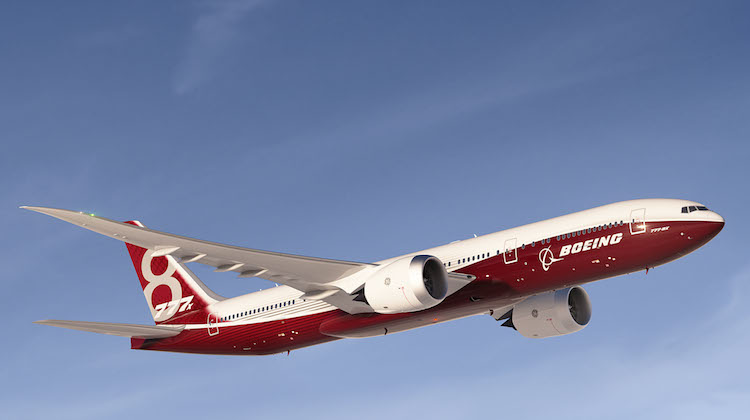
Boeing says it is studying some potential “tweaks” to its 777-8X in order to meet Qantas’s ultra-long haul needs.
Qantas has laid down the challenge to Airbus and Boeing to have an aircraft capable of operating nonstop from Austrlia’s east coast to London and New York by 2022.
The challenge, first announced in August, is called Project Sunrise, which is a nod to the “Double Sunrise” flights Qantas operated between Perth and Sri Lanka using Catalinas in WW2.
It pits the Airbus A350-900ULR (ultra-long range) against the Boeing 777-8X.
Boeing Commercial Airplanes vice president and chief project engineer for the 777X program Michael Teal said the airframer was working with Qantas to understand its requirements.
“The good thing about getting in on it early with Qantas and their request is really to understand their fleet requirements and the market demands,” Teal said during a conference call with reporters on Tuesday.
“If you look at the exact airplane we have on paper today, which is not at firm configuration, it falls short of all their desires but exceeds many of their desires. What we are doing today is looking at what knobs we can twist.
“We are highly motivated to participate with them on Project Sunrise and make sure that the aircraft offering we have will meet their needs.”
The 777-8X and larger 777-9X feature new General Electric GE9X-105B1A engines capable of delivering 105,000lb of thrust, new composite wings with folding wingtips to maintain its Code E rating at airports, as well as in-cabin enhancements such as larger overhead stowage and a wider cross section.
While the 777-8X is still in development and yet to reach firm configuration, the Boeing website lists the aircraft as having a range of 8,700nm and a passenger capacity of 350-375 passengers. The aircraft is expected to enter service in 2022.
However, the final specifications will only be known after further development of the aircraft design and an analysis of its engine performance. The GE9X engine is due to begin flight tests on General Electric’s flying testbed before the end of the year.
Boeing Commercial Airplanes vice president and general manager for the 777X program Eric Lindblad said design work on the -8X was underway.
Asked if Boeing would have to produce a special longer range variant of the 777-8X rather than just some “tweaks” to meet Qantas’s needs, Lindblad said: “Our preference obviously is to tweak the -8.”
“We really feel strongly about both the -8 and the -9 and for us it is really about taking the -8 and doing the things that Michael talked about and just making it a tweak to make that the offering that we need.”
Lindblad also expected the 777-8X to have a “greater customer base than what you see in the 777-200LR”.
“We’re certain of that,” Lindblad told reporters.
“We also expect that the -9 to be our top seller and the -8 will just fit inside of the fleet architecture that various of our customers want.”
While airline customers will have to wait until 2022 to get their hands on the 777-8X, the first A350-900ULR is less than a year away from commercial service.
Singapore Airlines (SIA) is the launch customer for the A350-900ULR, with which it plans to resume nonstop flights from Singapore to Los Angeles and New York in 2018.
Airbus has not published specific technical data on the A350-900ULR, stating only the long-range variant was capable of flying 19 hours and carry up to 165,000 litres of fuel. By comparison, the standard A350-900 has a range of 8,100nm and could take on 141,000 litres of fuel.
Currently, the world’s longest route by distance is Qatar Airways’ Doha-Auckland service at 7,848nm, operated by Boeing 777-200LR aircraft.
While most of the initial focus when Project Sunrise was publicly launched in August was on London Heathrow (9,188nm from Sydney) and New York JFK (8,647nm), Qantas has also earmarked Rio de Janeiro in Brazil (7,312nm) and Cape Town (5,946nm) in South Africa as new frontiers for nonstop services.
While it is true the 777-8X and A350-900ULR are capable of operating those routes, the range versus payload specifications were not quite where Qantas believed they needed to be for either airframes to ensure the routes were economically viable.
Qantas chief executive Alan Joyce said recently the choice of aircraft to complete these ultra-long haul missions would be represent the “last frontier in challenging the distance that has always been a problem for the Australian market”.
“We’ve gotten a great reaction from both manufacturers,” Joyce said during a speech to the Royal Aeronautical Society in London on November 27, according to an audio recording on the society’s website.
“Just before I came here I had a note from Tom Enders the CEO of Airbus saying that our team had gone to Toulouse talked to Airbus about their aircraft the A350 and he was very impressed with our approach.”
There are 340 orders for the 777X family of aircraft, with Emirates the largest customer with 150 aircraft.
The 777-9X is listed with a range of 7,600nm when carrying 400-425 passengers in a two-class configuration.











